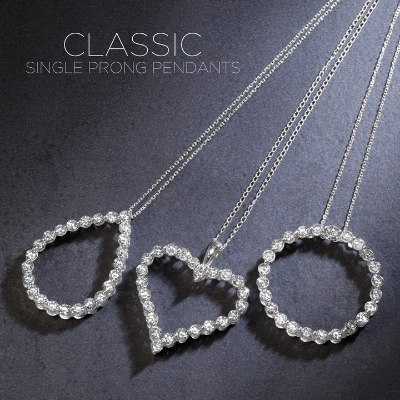Our story so far
Add a paragraph of text alongside an oversized heading. To help introduce your brand tell your story to your customers.
Use this area to help introduce your brand or tell your story to your customers.
We believe in diamonds cut for maximum brilliance, not maximum size.
When it comes to diamonds, some customers want to learn all they can about the 4 C's, and some just want us to make it easy. Either way, the best thing is to see a bunch of loose diamonds in person. You want to inspect your diamond just like a jeweler would... at a jewelry store. A jeweler would never buy a diamond unseen nor should you. Most of the other information, charts and grading reports exist to help you to see what you're really buying and what's worth paying for - not to replace your own judgments! So consider the 4 C's as a guide to finding the perfect balance between technical specifications and a beautiful diamond that also fits your budget. Here's a brief overview of each of the 4C's, but for a real education, you'll want to come into our jewelry store in Shreveport.
Cut not only describes the shape of the stone (round, princess, emerald and marquis etc), but also how well a cut and polished diamond's proportions affect its ability to sparkle and shine, which in turn, affects its beauty and price. A poorly cut diamond looks dull and lifeless. A well cut diamond displays the fire, brilliance and scintillation sure to get oohs and aahs from her friends.Because cut is so important, this one characteristic can affect the price of a diamond up to by 60%. When you find diamonds cheaper online, you can be sure they're diamonds with lower quality cuts and brilliance. And like most of the 4 C's, the only way to accurately gauge a diamond's cut and brilliance is with a loose stone, one that's out of the mounting. A mounted stone can "hide" a lot of internal clarity characteristics in cut, color, and even clarity. When you view a loose stone, you know that nothing is hiding any characteristics.


Color is both very subtle and very important. The more of a tint the diamond has, the less valuable it will be. But it can be hard to see the tint of a diamond without doing a side-by-side comparison of loose stones using proper lighting. You can do this at our store and see the difference yourself to determine how close to colorless your eyes demand and your budget will allow. But that said, once a diamond is mounted into a ring, it is difficult to tell the difference between a D and I color diamond - and that represents a 5-shade difference! In fact, even jewelers can't tell the difference between D and I when looking at a stone in the "face up" position once it's been mounted. This is why, even though the 4 C's are important, looking at the loose, unmounted stones with your own eyes and working with a jeweler you trust is even more important in making the right trade-offs to get you the most beautiful diamond for you and your budget.
It is extremely rare -- almost impossible -- to find a diamond with no internal characteristics (sometimes called "inclusions"). The complete scale takes you from "flawless" to visibly cloudy, from very rare to incredibly common diamonds. So remember the best way to see and judge clarity - and especially to judge how important it is for your own diamond - is to look at it with your own eyes. You don't want to end up paying a lot for a diamond's "rarity" when it won't affect you or your beloved's enjoyment of her engagement ring. A mounted stone can be set to hide multiple characteristics. For instance, you might select a diamond with an eye visible characteristic because the characteristic is off to the side of the stone where it could be hidden by the prongs of your mounting.Again, you'll want to work with a jeweler you trust to balance out each of the 4 C's against your desires and your budget.


Contrary to popular opinion, Carat is the WEIGHT of the diamond, not the size. You can have three diamonds that weigh the same and all three could have different sizes in diameters, due to the cut of the diamond. But variations due to cut can only do so much. So, on average, the higher the carat weight of a diamond, the bigger it will look. And as you'd expect, if the other 3 C's are the same, the higher the carat weight, the more the stone will cost.While it's not unusual to hear of 3/4 carat diamonds, it's also common for diamonds under one carat to be measured in points, where each point is 1/100th of a carat. Think of carats as dollars and points as pennies, so that a 3/4 carat diamond might be described as a 75pt diamond, as well.
Again, the best way to see and learn about diamonds is to come to our jewelry store in Shreveport.
Add text blocks to call out features, updates and more.

Add text with images to give and content and editorial feel. Drive traffic to key areas of your store
Add text with images to give and content and editorial feel. Drive traffic to key areas of your store
Add text with images to give and content and editorial feel. Drive traffic to key areas of your store
Add a paragraph of text alongside an oversized heading. To help introduce your brand tell your story to your customers.
Use this area to help introduce your brand or tell your story to your customers.